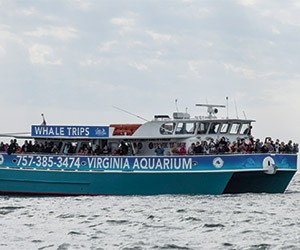Connected to coastal southeastern Virginia and the Hampton Roads region by the world engineering wonder that is the 17.6-mile Chesapeake Bay Bridge-Tunnel, the state’s Eastern Shore is steeped in maritime lore and natural history.
Dozens of shipwrecks haunt the waters on either side of this 70-mile strip of farmland and beaches, from 19th century schooners to the decaying WWII-era concrete ships offshore at Kiptopeke State Park. Count a Spanish galleon or two, as well, including La Galga, which reportedly ran aground off Assateague Island around 1750. No lives were lost—including the ponies aboard. Genetic evidence strongly suggests that these animals swam ashore and have lived and propagated here ever since.
Assateague is one of some 20 barrier islands forming a broken chain along the shore’s Atlantic-facing side. One pony herd lives in the island’s northernmost Maryland section, the other on Virginia’s 14,000-acre Chincoteague National Wildlife Refuge, with Chincoteague Island as its gateway.
These legendary roaming creatures will “un-tame” any group agenda. Self-led options include hiking or biking on marked trails, and limited vehicular access. Organized programs with pony-viewing include boat excursions with operators like Captain Dan’s Around the Island Tours and Assateague Explorer Cruises & Kayak Tours.
Groups can also visit the Chincoteague Pony Centre, or they can witness the spectacle each July—officially since 1925 but dating to the 1800s—of the annual Pony Swim and auction. First, “Saltwater Cowboys” round up the adult ponies and their foals on Assateague Island, and then they swim them over to Chincoteague Island in the centerpiece sunrise event. Paraded and corralled, the foals stay for auction (for herd control), while the adults swim back to Assateague. Attracting thousands of visitors, it’s mesmerizing to behold.
Featuring windswept white-sand beaches, dunes, marshes and coastal forest, the Refuge, protected and pristine, is also the setting for other guided animal and eco-experiences.
From whale-watching to wellness treatments, yet more unique encounters are calling groups in Virginia, the state for lovers—of wildlife.
Northern Virginia
For equine interludes of another breed entirely, groups meeting at the 168-room Salamander Resort & Spa in historic Middleburg can experience facilitated interaction and self-discovery with horses via the luxurious LEED-certified property’s remarkable EquiSpective program.
Set on 340 acres in Northern Virginia’s wine and horse country, versatile indoor and outdoor spaces at this luxurious LEED-certified (and pet-friendly) resort range from the 4,500-square-foot Middleburg Ballroom to the 42,000-plus-square- foot Great Lawn.
In addition, the resort’s nationally acclaimed Equestrian Center includes 25 on-site acres dedicated to riding and a 14,000-square-foot stable.
Also in Loudoun County, 21-acre Leesburg Animal Park features domestic and exotic animals such as llamas, camels, lemurs, gibbons and zebras.
Accommodating outdoor events on-site, the year-round park also takes its residents to groups. The fully insured and FDA-licensed Zoo-To-You program has supplied countless corporate, school, social and public events in the region for three decades.
Packages, all of which include at least one trained handler, set-up and clean-up, range from the four-animal indoor Barnyard Zoo to the Full Zoo, featuring 15 animals in an outdoor enclosure.
Closer to D.C., where groups have the event-capable Smithsonian-run National Zoo, Roer’s Zoofari, formerly the Reston Zoo, is a Fairfax County attraction offering educational encounters and hands-on interactions. The 30-acre venue features a free-flight aviary, reptile house and petting barn, and exotic creatures such as roaming kangaroos.
PageBreakIn Fairfax, group-capable Wolf Trap is the only U.S. national park dedicated solely to the performing arts. Established on 100 acres of farmland donated in 1930 by late founder Catherine Filene Shouse, the campus features spring and summer programs at the outdoor Filene Center and Wolf Trap Children’s Theatre-in-the-Woods, as well as fall and winter performances at the indoor The Barns at Wolf Trap. Borrowing from early 17th century wolf trapping in the area, the venue’s name carried on to Shouse’s farm and a local creek.
Central Virginia
Opened in 1895, The Jefferson in Richmond remains one of America’s classiest hotels. Coming off a just-completed reconstruction project that transformed 262 rooms into 181 spacious new rooms, this Beaux-Arts confection offers 26,000 square feet of meeting and function space.
Up until 1948, the Jefferson also featured live alligators, many reportedly “enthusiastically” donated by guests and locals, in the marble pools of its stunning Palm Court. Unknowing guests got quite a surprise, to say the least. Today, metal replicas preserve the legacy.
Live alligators, meanwhile, endure at another historic Richmond treasure, Maymont. This beloved event-capable 1893 mansion-estate features hundreds of animals in its Nature Center, Maymont Farm and wildlife exhibit area, ranging from black bears and birds of prey to otters and snakes.
Housing more than 190 global species, including endangered cheetahs, orangutans and rhinos, the conservation-focused Metro Richmond Zoo flexibly hosts walk-in groups, corporate events and other pre-scheduled gatherings. Attractions include daily keeper talks and penguin feedings, the Treetop Zoofari zipline and adventure park, and the rare opportunity to feed giraffes by hand.
Coastal Virginia
Accredited by the American Zoological Association (AZA), the historic Virginia Zoo in Norfolk features 500-plus animals representing some 115 species, including rarities such as the human-sounding masked lovebird. Set on 53 acres, the circa-1900 zoo hosts up to 2,000 people for private events, full catering included. Unique features include 10 lush themed gardens and the Animal Wellness Campus, a sustainably constructed, state-of-the-art medical and diet facility offering education programs in animal care and wellbeing.
Sanctuaries for Norfolk groups, meanwhile, include the 468-room Sheraton Norfolk Waterside Hotel. Inspiring a lasting downtown renaissance when it opened in 1976, the city’s only waterfront property today offers 46,000 square feet of flexible space. With 16 meeting rooms, the largest at 13,600 square feet, the hotel’s ideal group size is 300, up to a maximum of 1,200.
Last renovated in 2007, the pet-friendly property commenced a comprehensive $10 million renovation in January 2017. Slated for completion by May 2018, the two-phase project will refresh all guest rooms and meeting space, plus its restaurant and fitness center. Next door, the Waterside District is a new dining and entertainment experience that includes flexible event space for up to 6,000 delegates.
Opened in April 2017, The Main is an upscale $150 million mixed-use destination featuring the 300-room Hilton Norfolk, where group spaces include the 1,500-person Grand Ballroom. Creating Norfolk’s largest convention space, The Exchange at The Main offers 42,000 square feet of high-tech space and 39 meeting rooms, including the 18,382-square-foot Main Ballroom, the largest in Virginia.
Wildlife encounters for Hampton groups include observing migratory birds and other wetlands creatures on kayaking tours of Grandview Nature Preserve. Featuring some 150 domestic and exotic animals, Bluebird Gap Farm offers a pavilion with picnic tables and a grill for groups. Full-service group options include the Crowne Plaza Hampton Marina. The city’s only waterfront hotel features 173 newly renovated rooms and suites, many with bay views, plus 10,000 square of meeting space.
In neighboring Newport News, the Virginia Living Museum uniquely combines elements of an aquarium, botanical garden, native wildlife park, science center and planetarium. Founded in 1966 as the first living museum east of the Mississippi, the facility’s all-Virginia line-up of 250 living animal species, many endangered, includes loggerhead sea turtles and red wolves. Group programs include after-hours events, behind-the-scenes tours and private planetarium shows.
Virginia Beach groups have the Virginia Aquarium and Marine Science Center. The nationally acclaimed 800,000-plus gallon aquarium system includes the Restless Planet Gallery, featuring Komodo dragons, rare crocodiles and the 100,000-gallon Red Sea walk-through aquarium. Versatile event spaces include the Sharks and Sea Turtles Gallery, hosting dinners for 50 or receptions for 300; 260-seat National Geographic 3D Theater; and Bay and Ocean Pavilions, for up to 1,200 attendees. Groups can also book guided Sea Adventure boat tours to see dolphins, whales and other marine wildlife in their natural habitat.
Animal encounters at Williamsburg’s eco-friendly Busch Gardens amusement park include Eagle Ridge, a care facility for injured American bald eagles; Wolf Haven; Highland Stables, featuring traditional Scottish-style sheep-herding by border collies; and the Lorikeet Glen aviary, where visitors can feed exotic birds by hand.
Western Virginia
Once owned by Thomas Jefferson, Natural Bridge State Park, its ancient namesake solid rock bridge standing 215 feet tall, has been a Lexington and Rockbridge County draw for centuries. In the town of Natural Bridge, Virginia Safari Park is billed as “Virginia’s only drive-thru safari adventure.” The 180-acre property features free-roaming zebras, camels, antelope, elk and other animals, which visitors can feed from their cars. With discounts for 15 or more, groups can drive through or book wagon tours. In the pedestrian Safari Village, guests can see Bengal tigers, walk with kangaroos and feed giraffes.
Another local option is Natural Bridge Zoo (not associated with the Safari Park). Breeding rare, threatened or endangered species since 1972, the privately owned facility welcomes groups of 10 to 25 on Close Encounters tours such as feeding a lemur, meeting a Balinese python and even riding an African elephant.
The area’s primary group base is the Natural Bridge Historic Hotel & Conference Center, offering 116 rooms, two suites and 10,000 square feet of flexible space.
To the south, in Roanoke, AZA-accredited Mill Mountain Zoo houses rare and endangered creatures that include the red panda, red wolf and snow leopard. The zoo grounds are available for private all-day rentals or after-hours functions for 350-plus guests. Unique programs include the seasonal Breakfast with the Animals on Saturdays and traveling outreach.
About 100 miles north of Natural Bridge, Luray Zoo provides refuge for rescued animals. Programs include guided discovery tours, educational programs and since 1957, outreach, bringing animals to school, social and business gatherings. m







